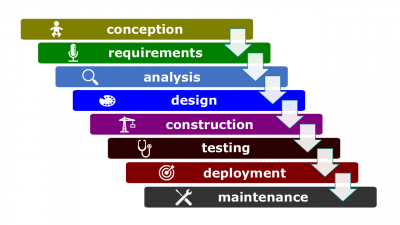Waterfall model
The Waterfall model (alternatively known as Waterfall methodology or Waterfall method; hereinafter, the Model) is a sequential design process where progress is seen as flowing steadily downwards through the phases. These phases vary from one model to another:
Waterfall model Initial (by Winston W. Royce) Requirements (system and software), captured in a product requirements document Analysis, resulting in models, schema, and business rules Design, resulting in the software architecture Coding: the development, proving, and integration of software Testing, resulting in the systematic discovery Debugging of defects and operations: the installation, migration, support, and maintenance of complete systems DOD-STD-2167A Preliminary Design Detailed Design Coding Unit Testing Integration and further testing Classic Conception Initiation Analysis Design Construction Testing Deployment and maintenance DREPD Deductive DREPD Discover Research Envision Plan Inductive DREPD Discover Rresearch Envision Plan
Definitions
According to the ITIL Foundation 4e by Axelos,
- Waterfall method. A development approach that is linear and sequential with distinct objectives for each phase of development.
